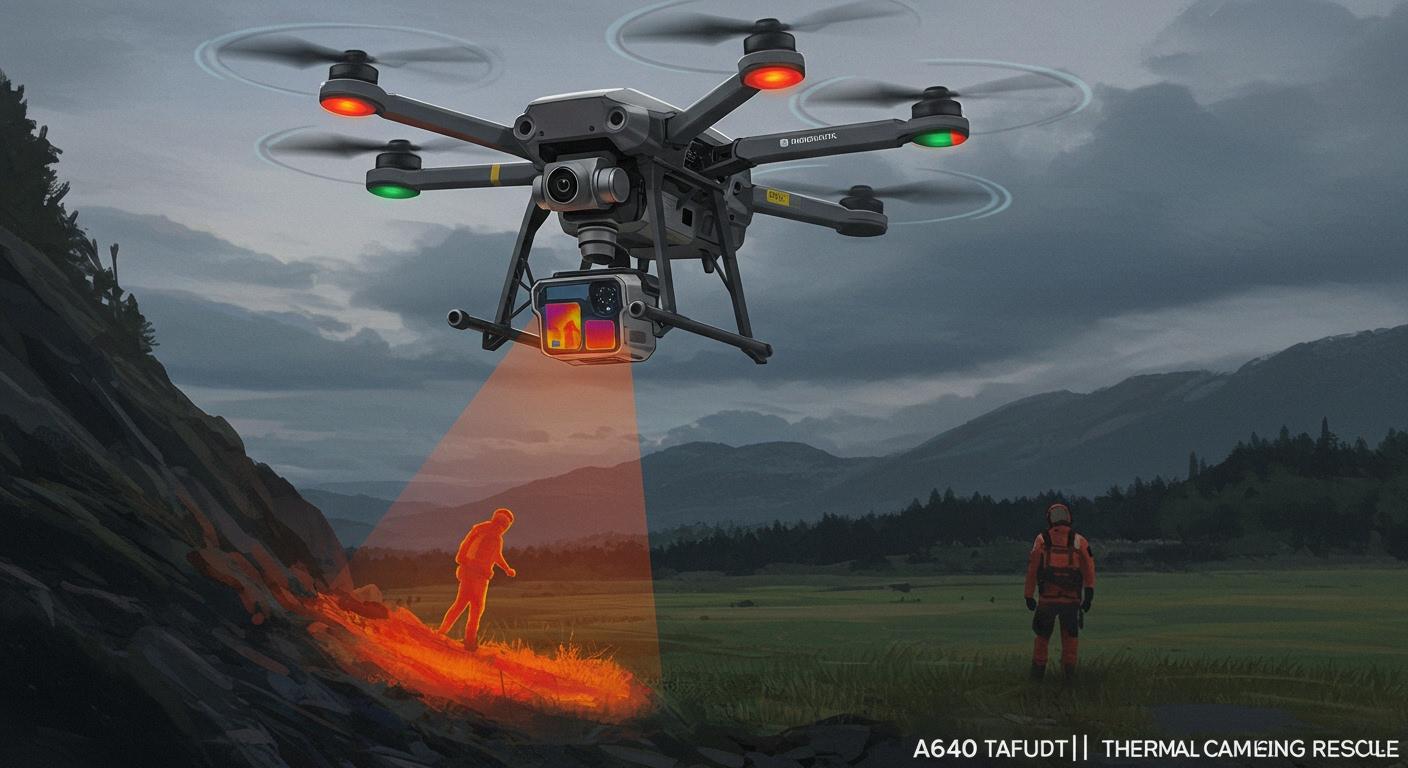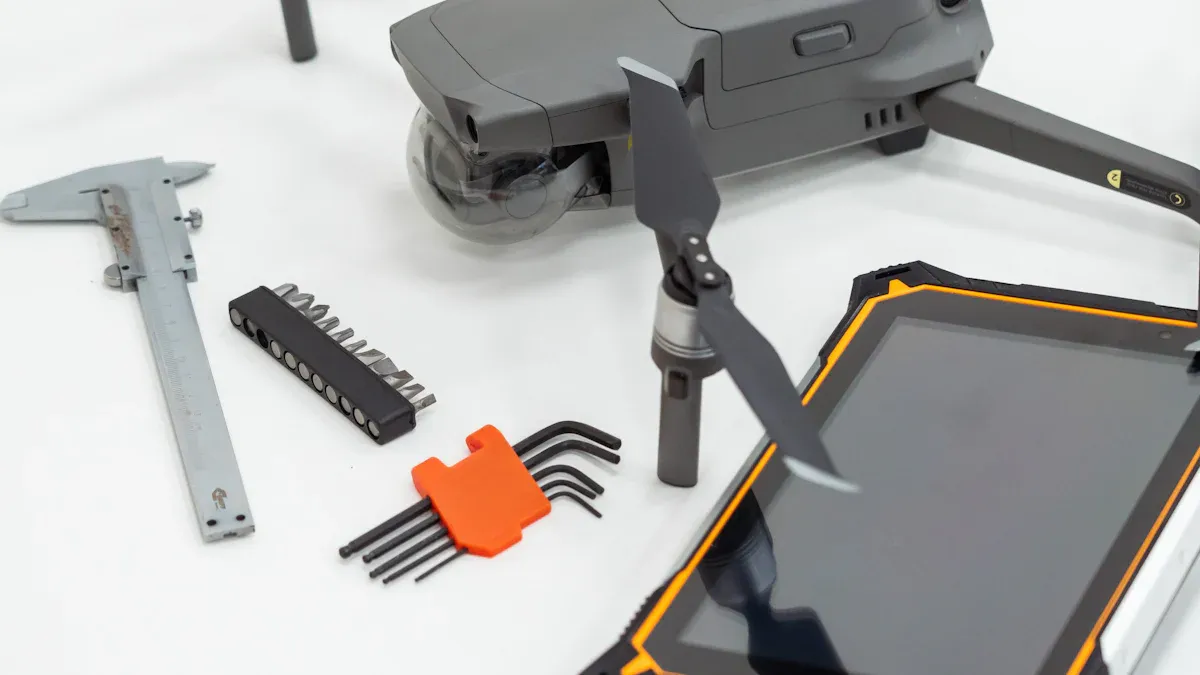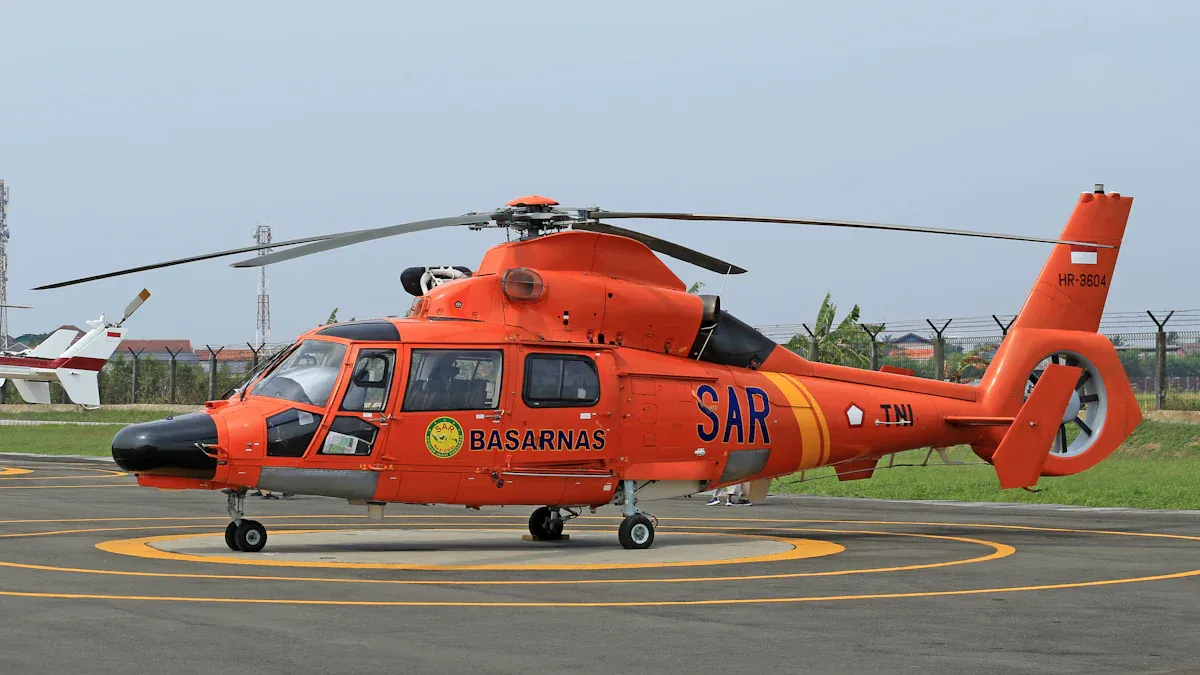
Adding a Turing A640 thermal camera for drone applications significantly enhances search and rescue operations. You can see better in dark or smoky environments, allowing for quicker identification of individuals in need. Thermal imaging enables you to locate people faster while also ensuring safety by revealing potential dangers early on. This technology helps you gain a clearer understanding of your surroundings, empowering you to make informed decisions during rescues. Whether you are a hobbyist or a professional, utilizing a thermal camera for drone use provides a substantial advantage in the field.
Key Takeaways
-
The Turing A640 thermal camera helps search and rescue teams see better in the dark or smoke. – Make sure your drone works with the A640 camera by checking the ports and using the right mounts. – Check cables and mounts before every flight to stop problems during important missions. – Change camera settings like brightness and contrast to get clear images in different places. – Clean the lens and test the connections often to keep your thermal camera ready to use.
Equipment and Compatibility
Thermal Camera for Drone Selection
When you begin a search and rescue job, you need the right gear. The most important tool is the thermal camera for drone work. The Turing A640 from Verytek is special because it has clear images and works well. Verytek is a top company with a smart team and new factories. They have lots of experience with car electronics and outdoor gear. You can count on them to use new ideas and technology.
Discover more about the Turing A640 Uncooled Infrared Module here.
To get ready, collect these things:
-
A drone that fits the camera (check if your drone can carry it and how to attach it)
-
Parts to mount or a gimbal
-
Cables for power and data
-
The user guide and software
Drone and Module Compatibility
You need to make sure your drone works with the thermal camera for drone. The A640 can connect in many ways, like USB, MIPI, DVP, LVDS, Camera Link, and analog video. Check your drone’s ports and see which one matches. Some drones need special parts or extra modules. If your drone uses a gimbal, make sure it can hold the thermal camera for drone and keep it steady when flying.
Tip: Always read your drone’s manual and the A640’s guide before you plug in any cables.
Safety Checks
Before you put on the thermal camera for drone, do some safety checks. Look at all cables and connectors to see if they are broken. Make sure the mounting parts are tight. The A640 can work in very hot or cold places, from -40°C to +80°C. Still, you should not let your gear get hit hard or wet. Check the power wires again so you do not use too much power or connect them the wrong way. These steps help keep your gear safe and make sure it works well outside.
Installation Steps

Mounting the A640
You need to mount the A640 thermal camera on your drone before you can use it. Start by choosing a stable spot on your drone. Most people use a gimbal or a special bracket. Make sure the mount holds the camera tightly. If you use screws, check that they fit and do not shake loose. If your drone has a gimbal, attach the camera so it stays balanced during flight. You want the lens to point straight ahead for the best view.
Tip: Always double-check the mount before flying. A loose camera can affect your images and may even fall off.
Power and Data Connections
After mounting the camera, connect the power and data cables. The A640 supports several interface options, so you can choose the one that matches your drone’s control unit. Look at the table below to see the most common choices:
|
Interface Type |
Description |
|---|---|
|
Digital Video |
|
|
Serial Communication Interface |
UART/I2C (optional) |
|
Extension Components |
USB2.0 / Analog video |
Find the right cable for your setup. Plug the power cable into the correct port. Connect the data cable to your drone’s control unit. If your drone uses USB, you can use a USB2.0 cable. If it uses MIPI or analog video, use the matching cable. Make sure each connection is tight and secure.
Note: If you are not sure which interface to use, check your drone’s manual or ask an expert.
Initial Setup
Once you connect everything, you can start the initial setup. Turn on your drone and the thermal camera. Watch for any lights or signals that show the camera is working. Open the software that comes with the camera. Check the live feed to see if the image looks clear. Adjust the angle if needed. If you see any problems, turn off the power and check your cables and mount again.
-
Test the camera by moving the drone a little. Make sure the image stays steady.
-
Try changing the brightness and contrast in the software.
-
If you want to zoom in, use the digital zoom feature.
Tip: Always test your setup before going out for a rescue mission. This helps you avoid problems in the field.
You now have your thermal camera ready for action. With careful mounting, secure connections, and a good initial test, you can trust your equipment to help you in search and rescue operations.
Configuration and Software
Camera Settings
You can make your A640 thermal camera work better by changing some settings. Start with brightness. Change it if it is bright or dark outside. If you fly in the sun, turn up the brightness. If you fly at night, turn it down to see better. Next, set the contrast. Lower contrast helps you see tiny details. Higher contrast makes animals or people stand out more. Polarity matters too. Use White-hot mode to find living things fast. Switch to Black-hot mode for sharper edges.
|
Setting |
Recommendation |
|---|---|
|
Brightness |
Change brightness for sunlight or nighttime. |
|
Contrast |
Lower contrast for details, higher for finding animals. |
|
Polarity |
White-hot finds living things, Black-hot shows edges better. |
The A640 has strong zoom features. Use the 16x digital zoom to look at things far away. For close-up views, use the 4x lossless zoom to keep the image clear. The camera’s smart image processing helps you see small things, even when zoomed in.
|
Feature |
Description |
|---|---|
|
Digital Zoom |
16x digital zoom helps you see far away and spot details. |
|
Lossless Zoom |
4x lossless zoom keeps pictures sharp when zooming in. |
|
Image Processing |
New software makes thermal images clearer than other cameras. |
Software Setup
After you set the camera, connect it to your drone’s software. Most drones let you see the thermal video live. Open the program that came with your camera or drone. Pick the A640 as your video source. Now you can watch what the camera sees on your screen. Some programs let you record video or take pictures. Save important images so you can look at them later.
Tip: Always look for software updates. Updates can add new tools or fix problems.
Testing the Feed
Test your setup before you go on a rescue. Turn on your drone and camera. Watch the live video for any problems. Move the drone and see if the picture stays clear. Try changing the camera settings and zoom to check if everything works. If something is wrong, check your cables and restart the system.
-
Test in bright and dark places.
-
Try both White-hot and Black-hot modes.
-
Use digital zoom to look at things far away.
A good test helps you trust your gear when you need it most.
Search and Rescue Operation Tips

Drones for Search and Rescue Best Practices
You can make your search and rescue missions better by following some easy steps. Always plan before you fly. Check the area and weather first. This helps you know what might happen and keeps everyone safe. Use drones for search and rescue with other search methods. This works well in forests, mountains, or cities. Practice flying your search and rescue drones often. Training helps you act fast when it matters. Always follow the rules for using drones in your area. This keeps your team safe and legal.
Tip: Training with thermal drones often helps you find people faster and makes your team stronger.
The Turing A640 thermal camera works in many places. You can trust its tough build and smart technology from Verytek. Their team uses new ideas and has lots of experience with car electronics and outdoor gear.
|
Environmental Factor |
Impact on Performance |
|---|---|
|
Weather Conditions |
|
|
Humidity |
Makes the image less clear. |
|
Fog |
Makes it hard to see details. |
|
Sunlight |
Makes images hard to see; best times are early or late in the day. |
|
Seasonal Variations |
Winter is better because of bigger temperature changes. |
Change your camera settings for these things. For example, use more contrast in fog or less brightness in strong sun.
Real-Time Monitoring
You need to watch the video feed live to help your search and rescue drones work better. Watch the thermal video as you fly. This helps you find lost people in thick forests or at night. Thermal drones use special sensors to see heat. You can spot people or animals even when it is very dark. Live video sends pictures to your team right away. This helps everyone make fast choices and work together.
-
Use live video to help your team.
-
Watch for changes in heat shapes.
-
Share live pictures with rescue workers for quick help.
Data Interpretation
You need to learn how to read thermal images from your search and rescue drones. Look for bright spots that show heat from people or animals. Dark spots usually mean cold ground or water. Change the polarity setting to make living things stand out. Use digital zoom to look at faraway places. Compare pictures from different times to see if something moved.
Note: Practice with your thermal drones helps you know what each picture means. This skill helps you do better in search and rescue missions.
Troubleshooting and Maintenance
Common Issues
Problems can happen during search and rescue operations. Sometimes the thermal camera does not show a clear picture. You might see blurry spots or odd colors. Loose cables can make the camera lose power. If the video feed stops, check the cables first. The camera may not listen to commands. Restart the system and try again. If the image freezes, turn off the drone and look at the camera. Always keep extra cables and mounting parts ready for quick fixes during search and rescue operations.
Tip: Write down any problems you find during search and rescue operations. This helps you fix them faster next time.
Maintenance Routine
Taking care of your gear keeps it ready for search and rescue operations. Clean the lens before each flight. Dust or water drops can block your view during search and rescue operations. Check the mounts after every use. Tighten screws and change old parts. Look at cables for damage. Replace any that look worn or broken. Test the camera’s power and data connections before search and rescue operations. Verytek’s smart team makes products for tough outdoor use. Their advanced factories help the A640 stay strong in search and rescue operations. You can trust their technology to work in hard places.
Maintenance Checklist for Search and Rescue Operations:
-
Clean lens and body
-
Check and tighten mounts
-
Inspect cables
-
Test power and data
-
Update software
Reliability Checks
Test your system before every search and rescue operation. Turn on the drone and camera. Watch the live feed for problems. Move the drone and see if the image stays clear. Change settings to check if the camera works. Record a short video during search and rescue operations and watch it. If you find problems, fix them before starting search and rescue operations. Good equipment helps you do well in search and rescue operations. Verytek’s smart team builds products you can trust for search and rescue operations.
|
Reliability Test |
What to Check During Search and Rescue Operations |
|---|---|
|
Power On |
Camera starts quickly |
|
Live Feed |
Image is clear and steady |
|
Settings Response |
Camera reacts to changes |
|
Recording |
Video saves and plays back |
Note: Always test your gear before search and rescue operations. This keeps your team safe and ready.
You now know how to add the A640 thermal camera to your drone for search and rescue missions. This setup helps you find people fast, even when conditions are hard. Many teams have used thermal drones to save lives, like finding climbers in the French Alps and missing people in Malibu. For your next search and rescue missions, try using groups of drones, better sensors, and smart ways to search. You can also use thermal imaging with night vision to get better results. If you want to make your search and rescue missions better, talk to experts or look for new technology.
FAQ
How do drones help in search and rescue applications?
Drones give you a fast way to scan large areas. You can use drones to find people in forests, mountains, or cities. Drones in search and rescue work well because they fly over places that are hard to reach. You get real-time images and data.
What makes the Turing A640 thermal camera good for drones in search and rescue?
You get clear thermal images with the A640. The camera works in tough weather and gives you strong results. Drones with this camera spot heat from people or animals. You can use it for search and rescue applications in day or night missions.
Can I use any drone for search and rescue applications?
You need drones that can carry the camera and have the right ports. Some drones work better for search and rescue applications because they have strong motors and stable flight. Always check your drone’s manual before you start. Drones in search and rescue need to be reliable.
How do I keep my drones working well during search and rescue missions?
You should clean the lens and check cables before each flight. Test your drones and camera before every mission. Make sure the mounts are tight. Update your software often. Drones in search and rescue need regular checks to stay safe and ready.
Why choose Verytek for drones in search and rescue?
Verytek has a strong R&D team and advanced factories. You get products made by experts in automotive electronics and outdoor solutions. Their team brings new ideas to drones for search and rescue applications. You can trust their technology for tough missions.
See Also
Utilizing Thermal Imaging Cameras for Effective Rescue Operations
Vanadium Oxide Thermal Imaging Cameras: A Rescue Essential
The Importance of Thermal Imaging Cameras in 2025
Solutions for Android Auto Disconnection Issues in Land Rovers
Best AI Video Boxes for Cars: 2025 Reviews
